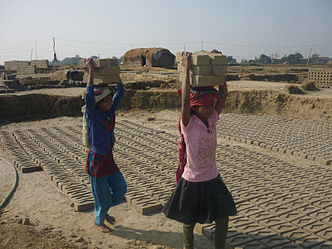Child labour


Child labour means that children are forced to work like adults and take part in an economic activity. According to the ILO International Labour Organization the term is applied to people up to age thirteen, or seventeen in case of dangerous work. Only about a fourth of the ILO members have ratified the respective convention, but the age limits are generally accepted.[5]
When children work like adults, this will deprive them of their childhood: Very often, they cannot attend regular school either. This kind of work is mentally, physically, socially or morally dangerous and harmful.
Child labour is fundamentally different from casual work done by children, like guarding other children, or helping here and there. Child labor is forbidden in most countries. In some places minor boys and girls work in tea stalls, restaurants, hotels and other small shops. Some work in huge factories like brick factories. The main reason why child labour occurs is poverty.
There are two kinds of work that minors can do:
- Some work they do is acceptable, as it is only light, or easy to do. Children can also do it while they are well-integrated into the family. This kind of work can be done in addition to an education the children are getting.
- The other kind of work is difficult to do, or it is physically exhausting. It may be dangerous, the children may be required to work for long hours and in humiliating clothing.
In general the second kind of work is usually labelled child labour. Estimates are that up to 350 million children are affected by child labour. Eight million of these are affected by the worst forms of child labour: they are child soldiers, they are forced into child prostitution, they are used for child pornography, they are child slaves, debt bondage or affected by human trafficking.
Often such cases are known through scandals in the mass media. In that manner, a working child is often seen as a slave, working in a sweat shop in a third world country, producing textiles, or as one of the street children in South America. The reality is different though: Such shops exist all over the world, also in countries like the United States or Italy. The fact that child labour is involved is often hidden: More than three quarters of this work is done in the sector of agriculture, or it has to do with activities done at home, in the context of the family. If child-slaves exist, they are only a minority. This form of work done by children also existed before industrialisation and globalisation, the two phenomena have made it more visible.[6]
References
- ↑ "Table 2.8, WDI 2005, The World Bank" (PDF). Archived from the original (PDF) on 2013-08-10. Retrieved 2015-06-04.
- ↑ Percentage of children aged 5–14 engaged in child labour
- ↑ The life of the industrial worker in nineteenth-century England. Laura Del Col, West Virginia University.
- ↑ The Factory and Workshop Act 1901
- ↑ Basu K. 1999. Child labor: cause, consequence, and cure, with remarks on International Labor Standards. Journal of Economic Literature, 37, pp. 1083-1119.
- ↑ Carol Bellamy, Executive Director (2011). "UNICEF State of the World's Children 1997". Oxford University Press for UNICEF. Archived from the original on 11 November 2020. Retrieved 26 August 2013.
![Child working in a mine, early 19th century England. Laws on child labour, the Factory Acts, were passed in Britain in the 19th century. Children younger than nine were not allowed to work, those aged 9–16 could work 16 hours per day: Cotton Mills Act. In 1856, the law permitted child labour past age 9, for 60 hours per week, night or day. In 1901, the child labour age was raised to 12.[3][4]](http://upload.wikimedia.org/wikipedia/commons/7/7b/Coaltub.png)